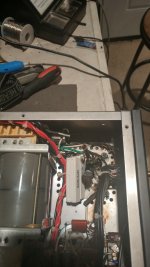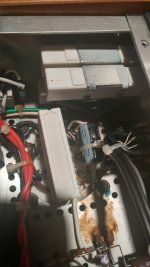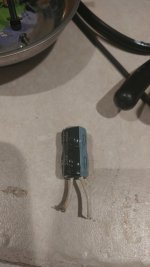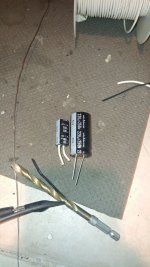I am having trouble getting my Almarro 318B to bias down to the correct 200mv range. I have put in new power tubes on a couple of occasions and it seems that within 2-3 weeks, the tubes start to run hot. I am already biasing at the minimum. Is the a symptom of a problem that needs fixing?
The problem seems to have gotten worse over the years. I have tried all the NOS Sovteks out there from the late 60s to early 80s.
I am going to bring the amp into a local amp repair technician but want to give him a start on the problem.
Thanks.
Dave
The problem seems to have gotten worse over the years. I have tried all the NOS Sovteks out there from the late 60s to early 80s.
I am going to bring the amp into a local amp repair technician but want to give him a start on the problem.
Thanks.
Dave
Sorry. I am not a technical guy and am interested in seeing if other Almarro owners have had this problem in the past.
Thanks.
Thanks.
There are number of items that can cause it on that Amp. ie. Leaky coupling cap between the 6SN7 and 6C33, problem developed at the negative bias voltage source, deteriorating cathode bypass cap or resistor. Your tech need to open it up and sort things out.
Schematic is in the operational manual.
Schematic is in the operational manual.
Thanks. Sounds like it could be a number of items so not a straight-foward issue. I have the schematic and will bring into the tech.
Gassy tubes in combination with a very large grid resistor that returns to the negative bias supply could be a problem.
What is the grid resistor value? Perhaps it is too large (makes it easy for the driver to swing the drive voltage; but it can let marginally gassy tubes go into run-away).
And what is the plate dissipation you are running (making the tube hot). If the tube starts to get too hot, then there may be additional outgassing from the hot tube elements. Some 6C33 are rated for 45 Watts, others are rated for 60 Watts.
The specification lists a maximum grid leakage to the other elements of 20uA (the tube can be that leaky). The maximum grid resistor allowed is 200k Ohms. 20uA times 200k Ohms is 4V. That is quite a large possibility of change to the Actual grid voltage (bias).
What is the grid resistor value? Perhaps it is too large (makes it easy for the driver to swing the drive voltage; but it can let marginally gassy tubes go into run-away).
And what is the plate dissipation you are running (making the tube hot). If the tube starts to get too hot, then there may be additional outgassing from the hot tube elements. Some 6C33 are rated for 45 Watts, others are rated for 60 Watts.
The specification lists a maximum grid leakage to the other elements of 20uA (the tube can be that leaky). The maximum grid resistor allowed is 200k Ohms. 20uA times 200k Ohms is 4V. That is quite a large possibility of change to the Actual grid voltage (bias).
Allow about 20 minutes for the 6C33C-B triodes to reach their full operating temperature. Set the bias voltage to 165 mV. Run the amplifier into a dummy load with a test signal to near full power for a few minutes and then check the bias which should be around 200 mV. With the amplifier idling the bias should slowly return to its' original setting. Check the condition of the cathode by-pass capacitors and replace them if it is necessary. A Nichicon 100 mFd. 250 V,(105 degree) capacitor is a suitable replacement.
There is various different schematic versions on that Almarro 318 amp identified by the serial number.
I got an Almarro for repair the last few days. Here I also had the problem of not being able to reduce the quiescent current sufficiently.
In the power supply there is a 16K resistor which reduces the negative bias voltage to -65V. By reducing the resistor the negative bias voltage can be increased to -100V (or more) (actually it should mean reducing).
In the power supply there is a 16K resistor which reduces the negative bias voltage to -65V. By reducing the resistor the negative bias voltage can be increased to -100V (or more) (actually it should mean reducing).
Sorry. I am not a technical guy and am interested in seeing if other Almarro owners have had this problem in the past.
Thanks.
I bought the original prototype (S/N #1) for the 318B and yes, these do tend to have a bias drift problem.
The amp runs hot as each tube draws ~200mA, so be sure all the components under the chassis are high-temp rated and the resistors equally rated.
All the recommendations on this thread are valid, additionally, make sure you replace the stock Russian tubes with a decent pair of 6SL7 / 6SN7.
I have serviced one of these locally a few times. I found that the big cathode bias resistors absolutely cooked the bypass caps, and even after performing that repair and moving things out of the way, they cooked another wire and caused more problems.
I would strongly recommend opening the amp up to see if there's weird stuff like this going on in there. Also don't fret if the bias wanders around a little bit. If anything, you could set it 10% low and just not worry about it.
I would strongly recommend opening the amp up to see if there's weird stuff like this going on in there. Also don't fret if the bias wanders around a little bit. If anything, you could set it 10% low and just not worry about it.
Attachments
Last edited:
Try changing the 6C33 grid resistor from 100k to 50k.
If the tube current is more steady over time and temperature, then grid current is the symptom (but the problem might be too much plate dissipation, too much filament voltage, or just a hot tube that out-gasses).
If the tube current is more steady over time and temperature, then grid current is the symptom (but the problem might be too much plate dissipation, too much filament voltage, or just a hot tube that out-gasses).
- Home
- Amplifiers
- Tubes / Valves
- Almarro 318B: Help with Biasing




